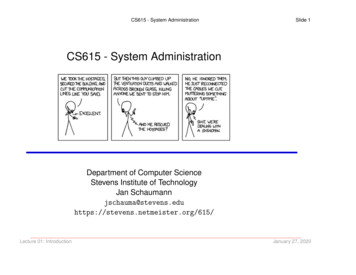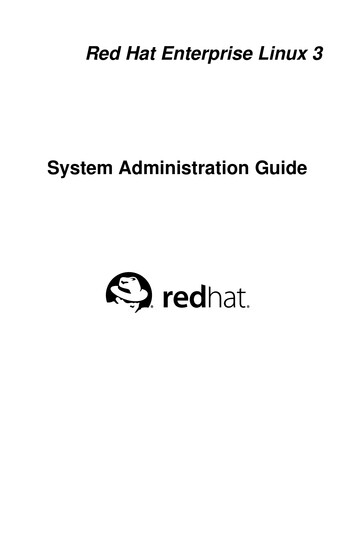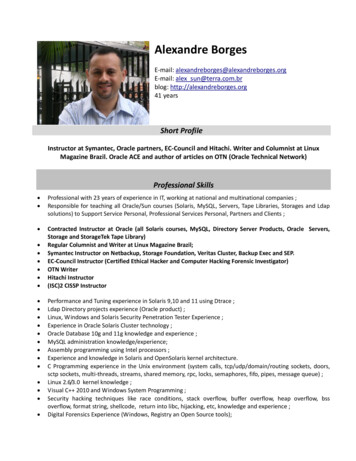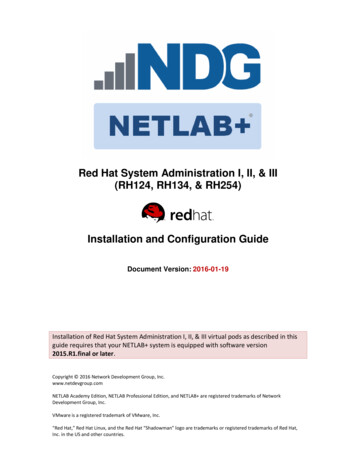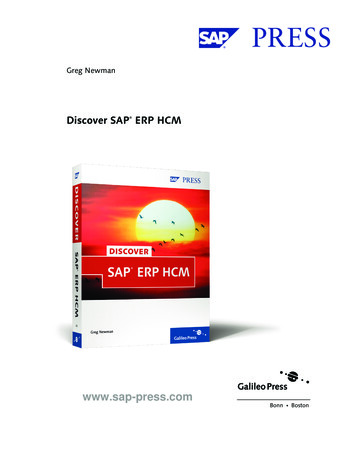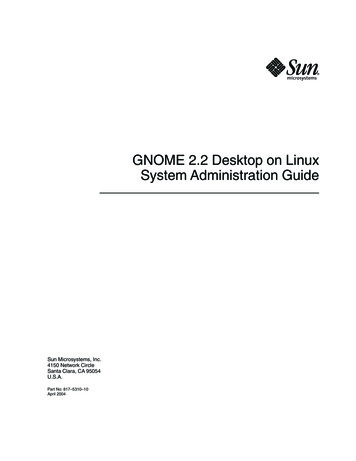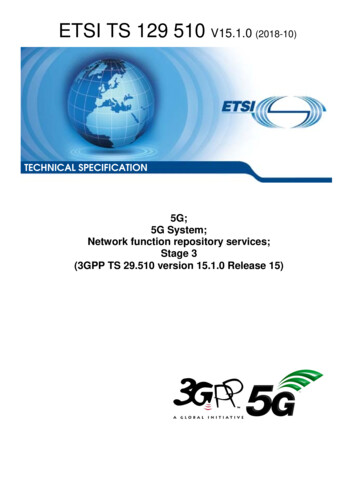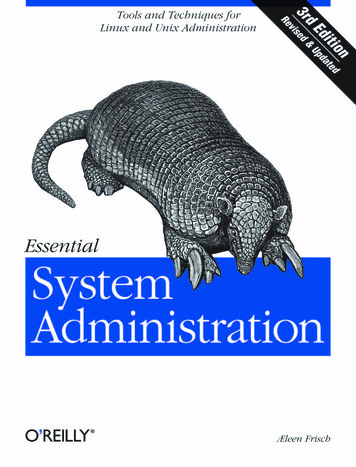
Transcription
Download from Wow! eBook www.wowebook.com Essential SystemAdministration
THIRD EDITIONEssential SystemAdministrationÆleen FrischBeijing Cambridge Farnham Köln Paris Sebastopol Taipei Tokyo
Essential System Administration, Third Editionby Æleen FrischCopyright 2002, 1995, 1991 O’Reilly Media, Inc. All rights reserved.Printed in the United States of America.Published by O’Reilly Media, Inc., 1005 Gravenstein Highway North, Sebastopol, CA 95472.O’Reilly Media, Inc. books may be purchased for educational, business, or sales promotional use.Online editions are also available for most titles (safari.oreilly.com). For more information contactour corporate/institutional sales department: (800) 998-9938 or corporate@oreilly.com.Editor:Michael LoukidesProduction Editor:Leanne Clarke SoylemezCover Designer:Edie FreedmanInterior Designer:David FutatoPrinting History:August 2002:Third Edition.September 1995:Second Edition.October 1991:First Edition.Nutshell Handbook, the Nutshell Handbook logo, and the O’Reilly logo are registeredtrademarks of O’Reilly Media, Inc. Essential System Administration, Third Edition, the image of anarmadillo, and related trade dress are trademarks of O’Reilly Media, Inc. Many of the designationsused by manufacturers and sellers to distinguish their products are claimed as trademarks. Wherethose designations appear in this book, and O’Reilly Media, Inc. was aware of a trademark claim,the designations have been printed in caps or initial caps.While every precaution has been taken in the preparation of this book, the publisher and authorassume no responsibility for errors or omissions, or for damages resulting from the use of theinformation contained herein.Library of Congress Cataloging-in-Publication DataFrisch, AEleenEssential System Administration/by AEleen Frisch.--3rd ed.p. cm.Includes index.ISBN 0-596-00343-9ISBN13 978-0-596-00343-21. UNIX (Computer file) 2. Operating systems (Computers) I. Title.QA76.76.063 F75 2002005.4'32--dc21[M]2002023321[05/07]
For Frank Willison“Part of the problem is passive-aggressivebehavior, my pet peeve and bête noire, and I don’tlike it either. Everyone should get off their highhorse, particularly if that horse is my bête noire.We all have pressures on us, and nobody’spressure is more important than anyone else’s.”***“Thanks also for not lending others your O’Reillybooks. Let others buy them. Buyers respect theirbooks. You seem to recognize that ‘lend’ and ‘lose’are synonyms where books are concerned. If Ihad been prudent like you, I would stillhave Volume 3 (Cats–Dorc) of theEncyclopedia Britannica.”
Table of ContentsPreface . . . . . . . . . . . . . . . . . . . . . . . . . . . . . . . . . . . . . . . . . . . . . . . . . . . . . . . . . . . . . . . . . xi1. Introduction to System Administration . . . . . . . . . . . . . . . . . . . . . . . . . . . . . . . . 1Thinking About System AdministrationBecoming SuperuserCommunicating with UsersAbout Menus and GUIsWhere Does the Time Go?361214312. The Unix Way . . . . . . . . . . . . . . . . . . . . . . . . . . . . . . . . . . . . . . . . . . . . . . . . . . . . . 32FilesProcessesDevices3353613. Essential Administrative Tools and Techniques . . . . . . . . . . . . . . . . . . . . . . . . 74Getting the Most from Common CommandsEssential Administrative Techniques74904. Startup and Shutdown . . . . . . . . . . . . . . . . . . . . . . . . . . . . . . . . . . . . . . . . . . . . 127About the Unix Boot ProcessInitialization Files and Boot ScriptsShutting Down a Unix SystemTroubleshooting: Handling Crashes and Boot Failures1271511691735. TCP/IP Networking . . . . . . . . . . . . . . . . . . . . . . . . . . . . . . . . . . . . . . . . . . . . . . . . 180Understanding TCP/IP NetworkingAdding a New Network HostNetwork Testing and Troubleshooting180202219vii
6. Managing Users and Groups . . . . . . . . . . . . . . . . . . . . . . . . . . . . . . . . . . . . . . . 222Unix Users and GroupsManaging User AccountsAdministrative Tools for Managing User AccountsAdministering User PasswordsUser Authentication with PAMLDAP: Using a Directory Servicefor User Authentication2222372562773023137. Security . . . . . . . . . . . . . . . . . . . . . . . . . . . . . . . . . . . . . . . . . . . . . . . . . . . . . . . . . 330Prelude: What’s Wrong with This Picture?Thinking About SecurityUser Authentication RevisitedProtecting Files and the FilesystemRole-Based Access ControlNetwork SecurityHardening Unix SystemsDetecting Problems3313323393483663733873918. Managing Network Services . . . . . . . . . . . . . . . . . . . . . . . . . . . . . . . . . . . . . . . 414Managing DNS ServersRouting DaemonsConfiguring a DHCP ServerTime Synchronization with NTPManaging Network Daemons under AIXMonitoring the Network4144524574694754759. Electronic Mail . . . . . . . . . . . . . . . . . . . . . . . . . . . . . . . . . . . . . . . . . . . . . . . . . . . 521About Electronic MailConfiguring User Mail ProgramsConfiguring Access AgentsConfiguring the Transport AgentRetrieving Mail MessagesMail Filtering with procmailA Few Final Tools52153253754259659961410. Filesystems and Disks . . . . . . . . . . . . . . . . . . . . . . . . . . . . . . . . . . . . . . . . . . . . . 616Filesystem TypesManaging Filesystemsviii Table of Contents617621
From Disks to FilesystemsSharing Filesystems63469411. Backup and Restore . . . . . . . . . . . . . . . . . . . . . . . . . . . . . . . . . . . . . . . . . . . . . . . 707Planning for Disasters and Everyday NeedsBackup MediaBacking Up Files and FilesystemsRestoring Files from BackupsMaking Table of Contents FilesNetwork Backup SystemsBacking Up and Restoringthe System Filesystems70771772673674274475912. Serial Lines and Devices . . . . . . . . . . . . . . . . . . . . . . . . . . . . . . . . . . . . . . . . . . . 766About Serial LinesSpecifying Terminal CharacteristicsAdding a New Serial DeviceTroubleshooting Terminal ProblemsControlling Access to Serial LinesHP-UX and Tru64 Terminal Line AttributesThe HylaFAX Fax ServiceUSB Devices76676977679479679779980713. Printers and the Spooling Subsystem . . . . . . . . . . . . . . . . . . . . . . . . . . . . . . . 814The BSD Spooling FacilitySystem V PrintingThe AIX Spooling FacilityTroubleshooting PrintersSharing Printers with Windows SystemsLPRngCUPSFont Management Under X81882984885886086487487814. Automating Administrative Tasks . . . . . . . . . . . . . . . . . . . . . . . . . . . . . . . . . . . 885Creating Effective Shell ScriptsPerl: An Alternate Administrative LanguageExpect: Automating Interactive ProgramsWhen Only C Will DoAutomating Complex Configuration Tasks with Cfengine886899911919921Table of Contents ix
Stem: Simplified Creation of Client-Server ApplicationsAdding Local man Pages93294215. Managing System Resources . . . . . . . . . . . . . . . . . . . . . . . . . . . . . . . . . . . . . . . 945Thinking About System PerformanceMonitoring and Controlling ProcessesManaging CPU ResourcesManaging MemoryDisk I/O Performance IssuesMonitoring and Managing Disk Space UsageNetwork Performance94595196397810011007101716. Configuring and Building Kernels . . . . . . . . . . . . . . . . . . . . . . . . . . . . . . . . . . 1024FreeBSD and Tru64HP-UXLinuxSolarisAIX System Parameters1026103110331046104717. Accounting . . . . . . . . . . . . . . . . . . . . . . . . . . . . . . . . . . . . . . . . . . . . . . . . . . . . . 1049Standard Accounting FilesBSD-Style Accounting: FreeBSD, Linux, and AIXSystem V–Style Accounting: AIX, HP-UX, and SolarisPrinting Accounting1051105210581066Afterword: The Profession of System Administration . . . . . . . . . . . . . . . . . . . . . . . 1069SAGE: The System Administrators GuildAdministrative Virtues10691070Appendix: Administrative Shell Programming . . . . . . . . . . . . . . . . . . . . . . . . . . . . 1073Index . . . . . . . . . . . . . . . . . . . . . . . . . . . . . . . . . . . . . . . . . . . . . . . . . . . . . . . . . . . . . . . . 1097x Table of Contents
PrefaceThis book is an agglomeration of lean-tos and annexesand there is no knowing how big the next addition willbe, or where it will be put. At any point, I can call thebook finished or unfinished.—Alexander SolzhenitsynA poem is never finished, only abandoned.—Paul ValeryThis book covers the fundamental and essential tasks of Unix system administration. Although it includes information designed for people new to system administration, its contents extend well beyond the basics. The primary goal of this book is tomake system administration on Unix systems straightforward; it does so by providing you with exactly the information you need. As I see it, this means finding a middle ground between a general overview that is too simple to be of much use toanyone but a complete novice, and a slog through all the obscurities and eccentricities that only a fanatic could love (some books actually suffer from both these conditions at the same time). In other words, I won’t leave you hanging when the firstcomplication arrives, and I also won’t make you wade through a lot of extraneousinformation to find what actually matters.This book approaches system administration from a task-oriented perspective, so itis organized around various facets of the system administrator’s job, rather thanaround the features of the Unix operating system, or the workings of the hardwaresubsystems in a typical system, or some designated group of administrative commands. These are the raw materials and tools of system administration, but an effective administrator has to know when and how to apply and deploy them. You needto have the ability, for example, to move from a user’s complaint (“This job onlyneeds 10 minutes of CPU time, but it takes it three hours to get it!”) through a diagnosis of the problem (“The system is thrashing because there isn’t enough swapspace”), to the particular command that will solve it (swap or swapon). Accordingly,this book covers all facets of Unix system administration: the general concepts,xiThis is the Title of the Book, eMatter EditionCopyright 2007 O’Reilly & Associates, Inc. All rights reserved.
underlying structure, and guiding assumptions that define the Unix environment, aswell as the commands, procedures, strategies, and policies essential to success as asystem administrator. It will talk about all the usual administrative tools that Unixprovides and also how to use them more smartly and efficiently.Naturally, some of this information will constitute advice about system administration; I won’t be shy about letting you know what my opinion is. But I’m actuallymuch more interested in giving you the information you need to make informeddecisions for your own situation than in providing a single, univocal view of the“right way” to administer a Unix system. It’s more important that you know whatthe issues are concerning, say, system backups, than that you adopt anyone’s specific philosophy or scheme. When you are familiar with the problem and the potential approaches to it, you’ll be in a position to decide for yourself what’s right foryour system.Although this book will be useful to anyone who takes care of a Unix system, I havealso included some material designed especially for system administration professionals. Another way that this book covers essential system administration is that ittries to convey the essence of what system administration is, as well as a way ofapproaching it when it is your job or a significant part thereof. This encompassesintangibles such as system administration as a profession, professionalism (not thesame thing), human and humane factors inherent in system administration, and itsrelationship to the world at large. When such issues are directly relevant to the primary, technical content of the book, I mention them. In addition, I’ve included otherinformation of this sort in special sidebars (the first one comes later in this Preface).They are designed to be informative and thought-provoking and are, on occasion,deliberately provocative.The Unix UniverseMore and more, people find themselves taking care of multiple computers, oftenfrom more than one manufacturer; it’s quite rare to find a system administrator whois responsible for only one system (unless he has other, unrelated duties as well).While Unix is widely lauded in marketing brochures as the “standard” operating system “from microcomputers to supercomputers”—and I must confess to having written a few of those brochures myself—this is not at all the same as there being a“standard” Unix.At this point, Unix is hopelessly plural, and nowhere is this plurality more evident than in system administration. Before going on to discuss how thisbook addresses that fact, let’s take a brief look at how things got to be the way theyare now.Figure P-1 attempts to capture the main flow of Unix development. It illustrates a simplified Unix genealogy, with an emphasis on influences and family relationships(albeit Faulknerian ones) rather than on strict chronology and historical accuracy. Itxii PrefaceThis is the Title of the Book, eMatter EditionCopyright 2007 O’Reilly & Associates, Inc. All rights reserved.
traces the major lines of descent from an arbitrary point in time: Unix Version 6 in1975 (note that the dates in the diagram refer to the earliest manifestation of eachversion). Over time, two distinct flavors (strains) of Unix emerged from its beginningsat AT&T Bell Laboratories—which I’ll refer to as System V and BSD—but there wasalso considerable cross-influence between them (in fact, a more detailed diagramwould indicate this even more clearly).AT&T Bell Labs- direct descent- strong influence(c.1969-1970)Version 6Download from Wow! eBook www.wowebook.com (1975)BSDVersion 7(1977)(1979)XENIX(1979 onward)System III(1982)4.2 BSDSystem V.2(1984)(1984)4.3 BSDSystem V.3(1985)(1986)4.4 BSDOSF/1System V.4(1993)(c.1992)(1988)Figure P-1. Unix genealogy (simplified)For a Unix family tree at the other extreme of detail, see http://perso.wanadoo.fr/levenez/unix/. Also, the opening chapters of Life with UNIX,by Don Libes and Sandy Ressler (PTR Prentice Hall), give a very entertaining overview of the history of Unix. For a more detailed written history, see A Quarter Century of UNIX by Peter Salus (Addison-Wesley).Preface This is the Title of the Book, eMatter EditionCopyright 2007 O’Reilly & Associates, Inc. All rights reserved.xiii
The split we see today between System V and BSD occurred after Version 6.* developers at the University of California, Berkeley, extended Unix in many ways, addingvirtual memory support, the C shell, job control, and TCP/IP networking, to namejust a few. Some of these contributions were merged into the AT&T code lines atvarious points.System V Release 4 was often described as a merger of the System V and BSD lines,but this is not quite accurate. It incorporated the most important features of BSD(and SunOS) into System V. The union was a marriage and not a merger, however,with some but not all characteristics from each parent dominant in the offspring (aswell as a few whose origins no one is quite sure of).The diagram also includes OSF/1.In 1988, Sun and AT&T agreed to jointly develop future versions of System V. Inresponse, IBM, DEC, Hewlett-Packard, and other computer and computer-relatedcompanies and organizations formed the Open Software Foundation (OSF), designing it with the explicit goal of producing an alternative, compatible, non-AT&Tdependent, Unix-like operating system. OSF/1 is the result of this effort (although itsimportance is more as a standards definition than as an actual operating systemimplementation).The proliferation of new computer companies throughout the 1980s brought dozensof new Unix systems to market—Unix was usually chosen as much for its low costand lack of serious alternatives as for its technical characteristics—and also as manyvariants. These vendors tended to start with some version of System V or BSD andthen make small to extensive modifications and customizations. Extant operatingsystems mostly spring from System V Release 3 (usually Release 3.2), System VRelease 4, and occasionally 4.2 or 4.3 BSD (SunOS is the major exception, derivedfrom an earlier BSD version). As a further complication, many vendors freely intermixed System V and BSD features within a single operating system.Recent years have seen a number of efforts at standardizing Unix. Competition hasshifted from acrimonious lawsuits and countersuits to surface-level cooperation inunifying the various versions. However, existing standards simply don’t address system administration at anything beyond the most superficial level. Since vendors arefree to do as they please in the absence of a standard, there is no guarantee that* The movement from Version 7 to System III in the System V line is a simplification of strict chronology anddescent. System III was derived from an intermediate release between Version 6 and Version 7 (CB Unix),and not every Version 7 feature was included in System III. A word about nomenclature: The successivereleases of Unix from the research group at Bell Labs were originally known as “editions”—the Sixth Edition,for example—although these versions are now generally referred to as “Versions.” After Version 6, there aretwo distinct sets of releases from Bell Labs: Versions 7 and following (constituting the original research line),and System III through System V (commercial implementations started from this line). Later versions of System V are called “Releases,” as in System V Release 3 and System V Release 4.xiv PrefaceThis is the Title of the Book, eMatter EditionCopyright 2007 O’Reilly & Associates, Inc. All rights reserved.
system administrative commands and procedures will even be similar under different operating systems that uphold the same set of standards.Unix Versions Discussed in This BookHow do you make sense out of the myriad of Unix variations? One approach is touse computer systems only from a single vendor. However, since that often has otherdisadvantages, most of us end up having to deal with more than one kind of Unixsystem. Fortunately, taking care of n different kinds of systems doesn’t mean thatyou have to learn as many different administrative command sets and approaches.Ultimately, we get back to the fact that there are really just two distinct Unix varieties; it’s just that the features of any specific Unix implementation can be an arbitrarymixture of System V and BSD features (regardless of its history and origins). Thisdoesn’t always ensure that there are only two different commands to perform thesame administrative function—there are cases where practically every vendor uses adifferent one—but it does mean that there are generally just two different approachesto the area or issue. And once you understand the underlying structure, philosophy,and assumptions, learning the specific commands for any given system is simple.When you recognize and take advantage of this fact, juggling several Unix versionsbecomes straightforward rather than impossibly difficult. In reality, lots of people doit every day, and this book is designed to reflect that and to support them. It will alsomake administering heterogeneous environments even easier by systematically providing information about different systems all in one place.BSDSystem V.3OSF/1System V.4SolarisFreeBSDHP-UXLinuxTru64AIX- UNIX definition- UNIX implementationFigure P-2. Unix versions discussed in this bookPreface This is the Title of the Book, eMatter EditionCopyright 2007 O’Reilly & Associates, Inc. All rights reserved.xv
The Unix versions covered by this book appear in Figure P-2, which illustrates theinfluences on the various operating systems, rather than their actual origins. If the version on your system isn’t one of them, don’t despair. Read on anyway, and you’ll findthat the general information given here applies to your system as well in most cases.The specific operating system levels covered in this book are: AIX Version 5.1 FreeBSD Version 4.6 (with a few glances at the upcoming Version 5) HP-UX Version 11 (including many Version 11i features) Linux: Red Hat Version 7.3 and SuSE Version 8 Solaris Versions 8 and 9 Tru64 Version 5.1This list represents some changes from the second edition of this book. We’vedropped SCO Unix and IRIX and added FreeBSD. I decided to retain Tru64 despitethe recent merger of Compaq and Hewlett-Packard, because it’s likely that someTru64 features will eventually make their way into future HP-UX versions.When there are significant differences between versions, I’ve made extensive use ofheaders and other devices to indicate which version is being considered. You’ll find iteasy to keep track of where we are at any given point and even easier to find out thespecific information you need for whatever version you’re interested in. In addition,the book will continue to be useful to you when you get your next, different Unixsystem—and sooner or later, you will.The book also covers a fair amount of free software that is not an official part of anyversion of Unix. In general, the packages discussed can be built for any of the discussed operating systems.AudienceThis book will be of interest to: Full or part-time administrators of Unix computer systems. The book includeshelp both for Unix users who are new to system administration and for experienced system administrators who are new to Unix. Workstation and microcomputer users. For small, standalone systems, there isoften no distinction between the user and the system administrator. And even ifyour workstation is part of a larger network with a designated administrator, inpractice, many system management tasks for your workstation will be left toyou. Users of Unix systems who are not full-time system managers but who performadministrative tasks periodically.xvi PrefaceThis is the Title of the Book, eMatter EditionCopyright 2007 O’Reilly & Associates, Inc. All rights reserved.
Why Vendors Like StandardsStandards are supposed to help computer users by minimizing the differences betweenproducts from different vendors and ensuring that such products will successfullywork together. However, standards have become a weapon in the competitive arsenalof computer-related companies, and vendor product literature and presentations areoften a cacophony of acronyms. Warfare imagery dominates discussions comparingstandards compliance rates for different products.For vendors of computer-related products, upholding standards is in large part motivated by the desire to create a competitive advantage. There is nothing wrong withthat, but it’s important not to mistake it for the altruism that it is often purported tobe. “Proprietary” is a dirty word these days, and “open systems” are all the rage, butthat doesn’t mean that what’s going on is anything other than business as usual.Proprietary features are now called “extensions” and “enhancements,” and definingnew standards has become a site of competition. New standards are frequently createdby starting from one of the existing alternatives, vendors are always ready to argue forthe one they developed, and successful attempts are then touted as further evidence oftheir product’s superiority (and occasionally they really are).Given all of this, though, we have to at least suspect that it is not really in most vendors’interest for the standards definition process to ever stop.This book assumes that you are familiar with Unix user commands: that you knowhow to change the current directory, get directory listings, search files for strings,edit files, use I/O redirection and pipes, set environment variables, and so on. It alsoassumes a very basic knowledge of shell scripts: you should know what a shell scriptis, how to execute one, and be able to recognize commonly used features like if statements and comment characters. If you need help at this level, consult Learning theUNIX Operating System, by Grace Todino-Gonguet, John Strang, and Jerry Peek,and the relevant editions of UNIX in a Nutshell (both published by O’Reilly & Associates).If you have previous Unix experience but no administrative experience, several sections in Chapter 1 will show you how to make the transition from user to systemmanager. If you have some system administration experience but are new to Unix,Chapter 2 will explain the Unix approach to major system management tasks; it willalso be helpful to current Unix users who are unfamiliar with Unix file, process, ordevice concepts.This book is not designed for people who are already Unix wizards. Accordingly, itstays away from topics like writing device drivers.Preface This is the Title of the Book, eMatter EditionCopyright 2007 O’Reilly & Associates, Inc. All rights reserved.xvii
OrganizationThis book is the foundation volume for O’Reilly & Associates’ system administration series. As such, it provides you with the fundamental information needed byeveryone who takes care of Unix systems. At the same time, it consciously avoids trying to be all things to all people; the other books in the series treat individual topicsin complete detail. Thus, you can expect this book to provide you with the essentialsfor all major administrative tasks by discussing both the underlying high-level concepts and the details of the procedures needed to carry them out. It will also tell youwhere to get additional information as your needs become more highly specialized.These are the major changes in content with respect to the second edition (in addition to updating all material to the most recent versions of the various operating systems): Greatly expanded networking coverage, especially of network server administration, including DHCP, DNS (BIND 8 and 9), NTP, network monitoring withSNMP, and network performance tuning. Comprehensive coverage of email administration, including discussions of sendmail, Postfix, procmail, and setting up POP3 and IMAP. Additional security topics and techniques, including the secure shell (ssh), onetime passwords, role-based access control (RBAC), chroot jails and sandboxing,and techniques for hardening Unix systems. Discussions of important new facilities that have emerged in the time since thesecond edition. The most important of these are LDAP, PAM, and advanced filesystem features such as logical volume managers and fault tolerance features. Overviews and examples of some new scripting and automation tools, specifically Cfengine and Stem. Information about device types that have become available or common on Unixsystems relatively recently, including USB devices and DVD drives. Important open source packages are covered, including the following additions:Samba (for file and printer sharing with Windows systems), the Amanda enterprise backup system, modern printing subsystems (LPRng and CUPS), font management, file and electronic mail encryption and digital signing (PGP andGnuPG), the HylaFAX fax service, network monitoring tools (including RRDTool, Cricket and NetSaint), and the GRUB boot loader.Chapter DescriptionsThe first three chapters of the book provide some essential background materialrequired by different types of readers. The remaining chapters generally focus on asingle administrative area of concern and discuss various aspects of everyday systemoperation and configuration issues.xviii PrefaceThis is the Title of the Book, eMatter EditionCopyright 2007 O’Reilly & Associates, Inc. All rights reserved.
Chapter 1, Introduction to System Administration, describes some general principlesof system administration and the root account. By the end of this chapter, you’ll bethinking like a system administrator.Chapter 2, The Unix Way, considers the ways that Unix structure and philosophyaffect system administration. It opens with a description of the man online help facility and then goes on to discuss how Unix approaches various operating system functions, including file ownership, privilege, and protection; process creation andcontrol; and device handling. This chapter closes with an overview of the Unix system directory structure and important configuration files.Chapter 3, Essential Administrative Tools and Techniques, discusses the administrative uses of Unix commands and capabilities. It also provides approaches to severalcommon administrative tasks. It concludes with a discussion of the cron and syslogfacilities and package management systems.Chapter 4, Startup and Shutdown, describes how to boot up and shut down Unix systems. It also considers Unix boot scripts in detail, including how to modify them forthe needs of your system. It closes with information about how to troubleshoot booting problems.Chapter 5, TCP/IP Networking, provides an overview of TCP/IP networking on Unixsystems. It focuses on fundamental concepts and configuring TCP/IP client systems,including interface configuration, name resolution, routing, and automatic IPaddress assignment with DHCP. The chapter concludes with a discussion of network troubleshooting.Chapter 6, Managing Users and Groups, details how to add new users to a Unix system. It also discusses Unix login initialization files and groups. It covers user authentication in detail, including both traditional passwords and newer authenticationfacilities like PAM. The chapter also contains information about using LDAP for useraccount data.Chapter 7, Security, provides an overview of Unix security issues and solutions tocommon problems, including how to use Unix groups to allow users to share filesand other system resources while maintaining a secure environment. It also discusses optional security-related facilities such as dialup passwords and secondaryauthentication programs. The chapter also covers the more advanced security configuration available by using access control lists (ACLs) and role-based access control(RBAC). It
also included some material designed especially for system administration profes-sionals. Another way that this book covers essential system administration is that it tries to convey the essence of what system administration is, as well as a way of approaching it when it is

